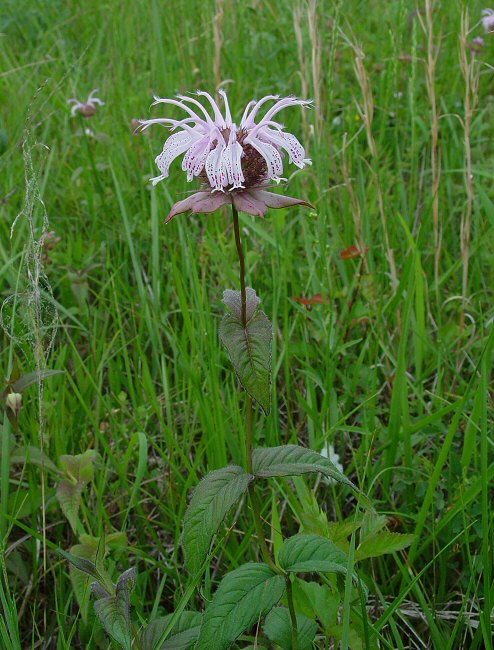Monarda bradburiana L.C. Beck
Beebalm

Native
CC = 5
CW = 5
MOC = 62
© DETenaglia
Monarda bradburiana L.C. BeckBeebalm | |
 |
Native CC = 5 CW = 5 MOC = 62 |
© DETenaglia |
|
Family - Lamiaceae Habit - Rhizomatous perennial forb. Stems - Erect, to 50 cm, usually unbranched, 4-angled, glabrous or sparsely pubescent with fine, spreading hairs, more densely so around the nodes.
Leaves - Opposite, simple, sessile or short-petiolate, decussate, the petioles to 5 mm long, the median leaves the largest. Blades 2-9 cm long, ovate to lanceolate, rounded to shallowly cordate at the base, angled or tapered to a sharply pointed tip, the margins with widely spaced, fine teeth, usually also hairy, the surfaces glabrous or sparsely to moderately pubescent with fine, spreading to loosely appressed hairs.
Inflorescences - Solitary terminal flower cluster, the outer bracts 15-20 mm long, narrowly ovate to linear-lanceolate, the margins entire but hairy, the surfaces usually glabrous, green to pale green or pinkish- to purplish-tinged. Innermost bracts 5-10 mm long, mostly linear, the margins hairy. Flowers +/-50 per cluster, sessile.
Flowers - Calyces 9-14 mm long, the outer surface moderately to densely pubescent with minute, spreading hairs, sometimes with sparse longer hairs or minute, gland-tipped hairs toward the tip and lobe margins, densely bristly-hairy in the throat, the lobes 2-4 mm long, long-tapered above a very short, triangular base, but lacking with a bristlelike extension. Corollas bilabiate, 24-38 mm long, white or pale pinkish-to lavender-tinged, usually with purple spots or mottling on the lower lip, sparsely to moderately pubescent with fine nonglandular hairs externally, lacking sessile glands, the lips with longer, denser hairs toward the tips, hairy in the throat, the upper lip about as long as the tube, arched, the lower lip somewhat shorter than the tube, 3-lobed with a pair of short lateral lobes and a flangelike 2-toothed extension at the tip of the central lobe. Stamens conspicuously exserted from the corolla. Filaments white, glabrous, 1.5 cm long. Anthers purplish-brown, 2.5 mm long. Style filiform, 3 cm long, glabrous, whitish to purple-tinged at the apex. Stigma 2-lobed. Ovary 4-lobed at the apex, green, glabrous, 1 mm long and broad.
Fruits - Nutlets 1.5-2.0 mm long, yellowish brown to brown. Flowering - April - June. Habitat - Rocky or dry open woods, savannas, borders of glades, fields, roadsides, railroads, often on acidic substrates. Origin - Native to the U.S. Lookalikes - Other species of Monarda. Except for M. fistulosa, these are much less common in Missouri. Other info. - This little species is common in the southeastern half of Missouri, but rare or absent in the northwest portion of the state. Its larger range comprises a tight cluster centered on Missouri and encompassing only a few states. The plant is easily recognized by its distinctive inflorescences, short stature, and opposite leaves with short (if any) petioles. The plant is the earliest of the genus to flower in Missouri. It is much shorter than the common wild bergamot (M. fistulosa) and is generally not highly colonial. Photographs taken off Hwy 47, Franklin County, MO., 5-10-04 (DETenaglia); also at Rockwoods Range Conservation Area, St. Louis County, MO, 5-9-2010 and 6-1-2011, Little Lost Creek Conservation Area, Warren County, MO, 5-28-2014, and Shaw Nature Reserve, Franklin County, MO, 5-17-2022 (SRTurner). |